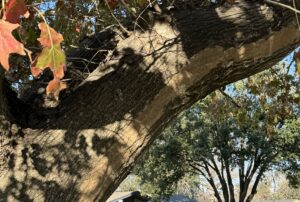In Texas, trees can be affected by Hypoxylon Canker, a pathogen that is relatively weak in nature. Many hardwood species such as Oak, Sycamore, Pecan, and Elms in various habitats can be affected. Hypoxylon enters a tree through wounding or injury. When you observe Hypoxylon on a tree, it indicates that the tree is already weakened or in a state of decline. Healthy trees are generally unaffected by this pathogen. Trees with this disease may exhibit yellow or brown leaves that may be smaller than normal, a thinning canopy and dying or dead branches. The presence of Hypoxylon leads to the death of the inner bark, causing the outer bark to peel off. In patches or strips, this fungus produces brown, powdery spores which eventually develop into a black, crusty growth where the bark is missing. Unfortunately when the disease is present, the tree will eventually die. There is no remedy, only prevention. This year, 2024, I am seeing more trees with this disease than ever before. Some stressors that can lead to Hypoxylon Canker are environmental conditions such as sub-freezing temperatures for several days, wounding from ice storms, followed by periods of drought, construction leading to root compaction and excessive moisture or flooding. As a tree owner, you can provide proper watering with adequate drainage, maintenance pruning, wound prevention during construction as well as regular arborist assessments to monitor the tree’s health. If you see what may be Hypoxylon Canker on your tree, have it assessed right away to get a diagnosis as well as the next steps to take.


